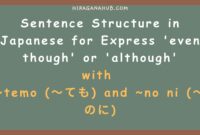Understanding the Use of Japanese Particles “Ni” and “De” (に、で)
Japanese particles can be tricky, and distinguishing between “Ni” (に) and
“De” (で) is crucial as both sometimes translate to “in” in English. This
brief guide will clarify when to use each particle correctly.
“De” (で) indicates the method or means, such as a mode of transport, or the
setting where an activity takes place. On the other hand, “Ni” (に) often
points to the destination or location in a non-action context.

Usage Rules of “Ni” (に) is used:
In contexts that emphasize location without action. For instance:
-
図書館にいます – としょかんにいます: I am
at the library. -
母はアメリカに生まれました –
はははアメリカにうまれました: My mother was born in
America.
These examples highlight that the verbs “to be” (います) and “to be born”
(生まれる) imply states of being rather than actions, making “Ni” (に) the
suitable choice.
Usage Rules of “De” (で) is utilized:
When the sentence involves an action taking place at a location. For
instance:
-
カフェで友達と話します –
カフェでともだちとはなします: I am talking with a friend at
a café. -
学校でサッカーをします –
がっこうでサッカーをします: We play soccer at school.
These sentences show action—talking and playing, respectively—making “De” (で)
the appropriate particle to use.
Vocabulary List:
| Kanji | Hiragana | Romaji | English |
|---|---|---|---|
| 図書館 | としょかん | toshokan | library |
| 生まれる | うまれる | umareru | to be born |
| 話す | はなす | hanasu | to talk |
| 学校 | がっこう | gakkou | school |
| サッカー | サッカー | sakkaa | soccer |
This guide is designed to be easily
understood by learners of all ages, providing
clear examples and a handy vocabulary table
for quick reference.


